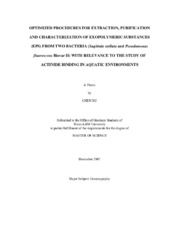| dc.description.abstract | The extracellular polymeric substances (EPS) of marine bacterium Sagittula stellata
and soil bacterium Pseudomonas fluorescens Biovar II, were extracted by six methods
referred to the bibliography, efficacies of which were compared based on the EPS yield,
composition as well as cell disturbance. Purification methods on these EPS were also
improved, which proved to be more cost-effective and involve less interference from
broth, compared to previous methods. Size exclusion chromatography (SEC) proved to
be a useful tool, providing the “fingerprints” of the EPS extracted by different methods
or after each purification step. Studies of the EPS production and composition at
different growth stages provided abundant information and a basis for further in-depth
studies. Results from SEC demonstrated that bacterial EPS had a constant molecular
weight distribution all through the life but with various polymers in different proportions.
Three fractions were successfully isolated by a combination of SEC and anion exchange
chromatography for “non-attched” EPS produced by Pseudomonas flurorescens Biovar
II. Protein turned out to be a major component of EPS in their native states, which was mixed with the broth material and couldn’t be recognized previously. The EPS harvested
at the optimal time of the bacterial life was purified according to the improved method
and was more enriched in polysaccharides, with small amounts of proteins, giving the
molecules amphiphilic properties. In addition, simultaneous determination of neutral
sugars and uronic acids by GC-EI-MS provided more information on the
monosaccharide composition of the exopolysaccharides. Isoelectric focusing (IEF)
spectra of the bacterial EPS spiked with Pu/Th, and Pu-enriched Rocky Flats
Environmental Technology Site (RFETS) soil organic colloid spiked with Th showed
similar activity distributions of both actinides along the pH gradient, with the activities
of both actinides focusing on the low pH region. Characterizations of this Pu-enriched
IEF extract from RFETS soil by spectrophotometric methods and ATR-FTIR indicated
the co-presence of lipids, proteins and polysaccharides, in contrast to the bacterial EPS,
which showed a simpler composition. This suggests that Th/Pu binding to organic
macromolecules is more determined by the availability of binding functional groups
rather than the exact specific compounds. | en |


